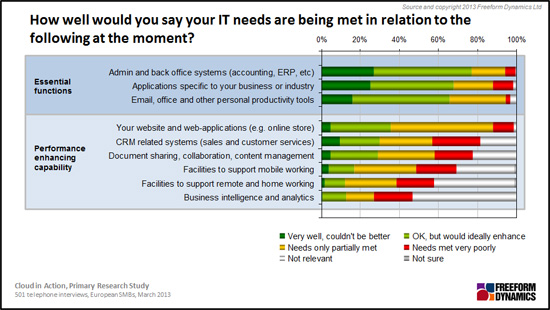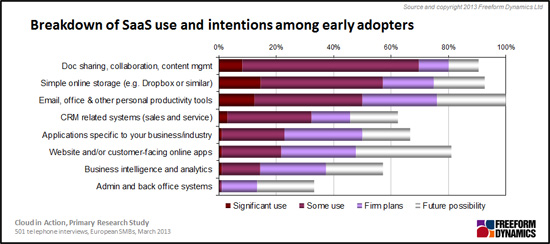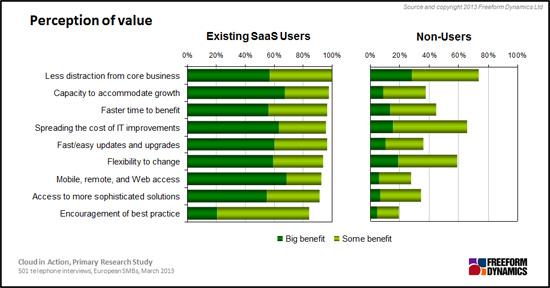By Dale Vile
SMBs and cloud computing are a match made in heaven. That’s the theory, at least, and it’s based on the principle that smaller businesses have less in the way of cash and skilled resources to throw at IT investments, while the cloud minimises up-front costs and reduces the operational burden.
In a research report just published by Freeform Dynamics and Symantec, though, we take a closer look at how the promise of cloud computing, Software as a Service (SaaS) in particular, is translating to real activity in the SMB space. This is based on a European wide study of just over 500 organisations in the 10 to 250 employee range across a variety of industry sectors.
One of the things that immediately struck us when we started analysing the research data was the degree to which many SMBs are currently under-exploiting IT in a number areas that by contrast are typically business-as-usual among larger enterprises. While smaller businesses usually do an OK job of covering back office and core business system requirements, most are either overlooking or failing to act on opportunities associated with what we might call ‘business performance enhancing’ solutions:

As we can see from the above chart, gaps or lack of appreciation are evident in areas such as Web facing customer applications, CRM, collaboration, mobile/flexible working and business intelligence – the kind of solutions that enhance business effectiveness and differentiation, as well as efficiency.
So what has this got to do with SaaS? Well, when we turn our attention to the subset of participants in our study (approximately 1 in 5) who have taken SaaS on board, we see a heavy focus on these performance enhancing solutions:

We haven’t shown it here, but other areas in which SMBs are often weak include operational management, data protection and security, and we see SaaS activity in these too:

It’s obvious when you see it all laid out like this that SaaS is being used by SMBs largely to up their game. They are putting business enhancing and risk management solutions in place that have historically been regarded as too complex, costly or overkill to implement through traditional on premise systems.
A couple of important ‘so what?’ points fall out of this for resellers.
Firstly, a lot of the rhetoric we hear about SaaS being primarily concerned with cost saving is missing the point. It’s not that cost (particularly up front capital investment) is not an important factor, it’s that SMBs are typically not migrating existing systems to SaaS (with the possible exception of email), so the conversation about direct savings is often going to be irrelevant. The real cost-related selling point of SaaS is that it reduces the immediate cash/funding required to do new things that you would ordinarily regard as cost prohibitive.
The second point is really looking at the same principle from the other perspective, i.e. the reseller’s. If SMBs are taking SaaS on board to implement solutions that they would not buy from you in traditional hardware and software form, then we clearly have an incremental business opportunity here. Incorporate the right mix of SaaS options into your portfolio, and you’ll be opening up sales opportunities that wouldn’t otherwise exist.
OK, so that’s easy to say and harder to put into practice, and we would not want to trivialise the investment and effort required for a reseller to extend its product business into the world of SaaS. But the data would suggest that it’s worth considering the opportunity rather than getting too hung up with fears of lack of demand or cannibalisation of your existing business.
Having said this, SaaS users at the moment are still in the minority in the SMB space, with most of the activity in the 100-250 employee range, and awareness and acceptance of SaaS is actually very low below this. The upshot is that a little more education is often required in the sales cycle. But if you put the proposition clearly, you should be pushing against an open door more often than not.
And if you do get into formulating SaaS propositions, messaging and pitches for use in the marketing and sales cycle, the research provides some pointers here too based on the views of early adopters:

There’s a lot more that came out of the study that will help with targeting, planning, messaging and objection handling (e.g. on the old chestnut of security) so if you are looking at developing your SaaS related activities, we would encourage you to download the full research report which is available from here.
CLICK HERE TO VIEW ORIGINAL PUBLISHED ON

Registration required
Dale is a co-founder of Freeform Dynamics, and today runs the company. As part of this, he oversees the organisation’s industry coverage and research agenda, which tracks technology trends and developments, along with IT-related buying behaviour among mainstream enterprises, SMBs and public sector organisations.





Have You Read This?
From Barcode Scanning to Smart Data Capture
Beyond the Barcode: Smart Data Capture
The Evolving Role of Converged Infrastructure in Modern IT
Evaluating the Potential of Hyper-Converged Storage
Kubernetes as an enterprise multi-cloud enabler
A CX perspective on the Contact Centre
Automation of SAP Master Data Management
Tackling the software skills crunch